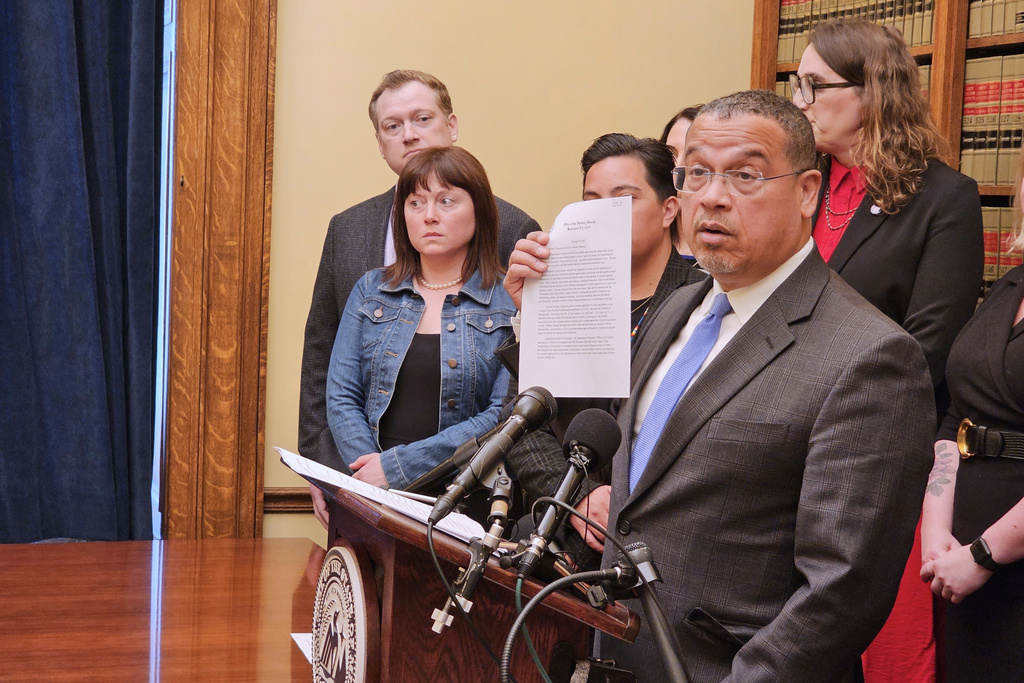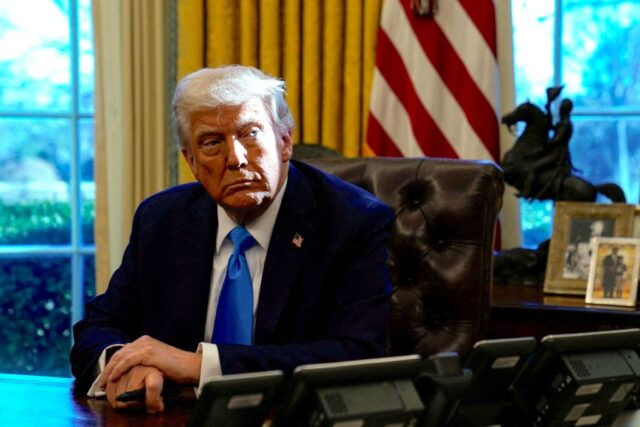Before winning reelection, President Donald Trump campaigned on the promise to shake things up in Washington. In his first two weeks in office, that shakeup has included orders to freeze nearly all foreign aid and, for a chaotic 24 hours or so, all federal grants and loans.
While two judges have hit pause on Trump’s federal spending freeze, his administration has signaled the matter is far from resolved.
The brewing showdown is over a centuries-old process called “impoundment” in which the president — whose administration which is tasked with distributing funds — doesn’t allow congressionally appropriated funding to be spent.
WATCH: Protests erupt as Elon Musk moves to gut government agencies
It’s a concept that’s normally so dry, so esoteric and so distanced from Americans’ everyday lives that your eyes may start to water as you try to recall whether this was ever covered in school. Yet at the heart of this legal battle is a key question of American democracy: whether, under the U.S. Constitution, the president has more spending authority than either Congress or the Supreme Court has ever previously permitted.
Trump himself has long argued that the executive branch has the power to spend or freeze federal funds, something most experts say is Congress’ purview, and has vowed to use impoundment to cut federal spending.
Here’s what to know about impoundment and why it’s so important now.
First, a history lesson
When the founders of the United States were drafting the Constitution in the late 18th century, a disagreement arose among some of the framers over how much spending power Congress should have. The debate wasn’t settled until the 1930s, when the Supreme Court ruled that the legislative branch had broad authority to tax and spend the nation’s money, also called the “power of the purse.”
That power has always belonged solely to Congress, said Richard Kogan, a senior fellow at the Center on Budget and Policy Priorities.
“It has always been the case that Congress provides money in a specific amount for a specific purpose, or sometimes an open-ended amount for a specific purpose, and the president is required to follow the law,” Kogan said. “He’s the chief executive, not the chief lawmaker.”
Congress’ power of the purse “really does preclude the president from unilaterally deciding not to spend money that Congress has already approved,” said Rachel Snyderman, managing director of economic policy program at the Bipartisan Policy Center. “It’s the core demonstration of the checks and balances that exist within the federal government.”
Crucially, the early Supreme Court decisions didn’t address whether the executive branch had any substantial power of its own over spending.
Then came President Richard Nixon.
Nixon used impoundments and Congress pushed back
Though Nixon is better known for other legal shenanigans, he also went bananas impounding congressionally appropriated funds.
The volume of impoundments Nixon implemented demonstrated “there was a need for an overhaul of the federal budget process, and a formal mechanism through which the president could exercise that check-and-balance and request of Congress a change in previously appropriated funds,” Snyderman said.
President Richard Nixon in 1972. Photo by Bettmann/ Getty Images
In 1974, Congress passed the Congressional Budget and Impoundment Control Act (ICA), which regularized the process of impoundment, granting the president a little more authority than before, Kogan said.
But the ICA doesn’t allow the president to unilaterally change the budget, he said.
WATCH: Is expanding presidential power inherently bad for democracy?
“It doesn’t change in any way the underlying premise that when Congress writes a budget law, it means it,” he added. “And [the president’s] job is to execute it, not to defy it.”
While the Nixon administration released funds after successful lawsuits against them on a number of occasions, there was one case that reached the Supreme Court. In Train v. City of New York, the court ruled unanimously that the president did not have the power to withhold city’s funding.
Importantly, the case was not a dispute about the ICA but about a specific impoundment. The Supreme Court has not ruled on the constitutionality of the ICA.
Are there ways a president can withhold funds?
The president does get input on how Congress wants to spend money. Appropriation generally involves extensive negotiations with the president’s administration. The president can also veto the budget passed by Congress. Former President Joe Biden signed a short-term funding bill in December, which runs out mid-March, when Congress will need to propose new spending and Trump will get to sign or veto.
The ICA also provides two avenues for the president to withhold funds: deferrals and rescissions.
Deferrals are generally uncontroversial. It’s a way for the government to save money on appropriated funds, or delay using those funds until they’re needed. When Congress passes yearly disaster aid, Snyderman said, the administration can temporarily hold it to ensure there’s enough funding for hurricane season. The Office of Management and Budget oversees deferrals, which do not need congressional approval, though they can be overturned by Congress.
“The executive branch has every intent to still spend that money. It’s just temporarily holding it so that it can achieve some sort of cost savings or administrative efficiencies,” said Snyderman, who also previously worked for OMB.
A rescission, however, is an agenda-related funding freeze. It’s for when Congress appropriates money that, for policy reasons, the president does not want spent. The process of requesting a rescission begins with the president sending an official letter to the House and Senate Appropriations Committees, which must approve, disapprove or ignore the request. If it’s denied, the process ends there. If it’s approved or ignored, it goes to the full Congress, which has a period of 45 days to consider it.
Here’s where Congress really demonstrates its power: The House and Senate both must approve the request for the funding to be rescinded. If Congress denies it or does nothing, the request dies and the administration is legally obligated to release the funds.
The president can also propose rescissions to budgets that aren’t through the ICA, Snyderman said, such as working closely with Congress to propose legislation to withhold previously allocated funding.
The passage of the ICA also established the House and Senate Budget Committees, as well as the Congressional Budget Office. The act specifies that the president can only impound discretionary funds, including infrastructure and defense spending, and not mandatory funding, such as Social Security, Medicaid and Medicare.
And it gave the Government Accountability Office oversight of the ICA, including the ability to sue the administration if it believes funds have been withheld in violation of the ICA. The GAO is headed by a comptroller who serves a 15-year term; the current U.S. comptroller general is Gene Dodaro, who was confirmed in 2010.
In 1975, then-Comptroller General Elmer B. Staats took President Gerald Ford to court over impounded funds for subsidized housing, the only time GAO has sued a president over impounded money.
Why are we suddenly talking about impoundment?
Impoundment has become a topic du jour because Trump and members of his administration have said they believe the ICA is unconstitutional. Supporters of this argument say Article II of the Constitution, which grants the president “the entirety of the executive power,” gives the president more power over federal funding than just apportioning the funds.
Trump claimed in a June 2023 campaign video that historically “it was undisputed that the president had the constitutional power to stop unnecessary spending” by using impoundment. He promised to use “the president’s long-recognized impoundment power to squeeze the bloated federal bureaucracy for massive savings.”
READ MORE: Trump makes moves to maximize his power in first days of presidency
In the attempt to freeze federal funds, there’s no evidence that the Trump administration sent an official letter to Congress requesting a rescission.
GAO has said in the past that administrations can impose programmatic delays without violating the ICA, said Zachary Price, professor at University of California College of Law, San Francisco.
That’s how Russell Vought, Trump’s nominee for OMB director, characterized the administration’s actions.
“What the president has unveiled already are not impoundments. They are programmatic delays,” Vought said in his confirmation hearing on Jan. 22.
“To say you can just automatically pause all federal spending goes well beyond what’s been done with that theory before,” Price said.
In 2019, Trump’s OMB impounded aid designated for Ukraine, a chapter in history that is remembered more for the phone call between Trump and Ukrainian President Volodymyr Zelenskyy. The GAO deemed that impoundment a violation of the ICA in a 2020 report.
The Trump administration argued that they delayed releasing the money to review the funds wouldn’t be used in ways counter to the president’s foreign policy goals. But the comptroller of the GAO said the delay was “not a programmatic delay,” but was withheld for policy reasons and was therefore an illegal deferral.
Vought has repeatedly said he believes the ICA is unconstitutional, including during his confirmation hearing. Sen. Patty Murray, D-Wash., asked whether he’d follow the ICA.
“We will faithfully uphold the law. The president ran on the notion that the Impoundment Control Act is unconstitutional. I agree with that,” Vought said.
Vought alluded to the president and Department of Justice planning to legally review “the parameters of the law with regard to the Impoundment Control Act,” but Trump’s pick for OMB director has not outright said the administration hopes to contest it in federal court.

















































